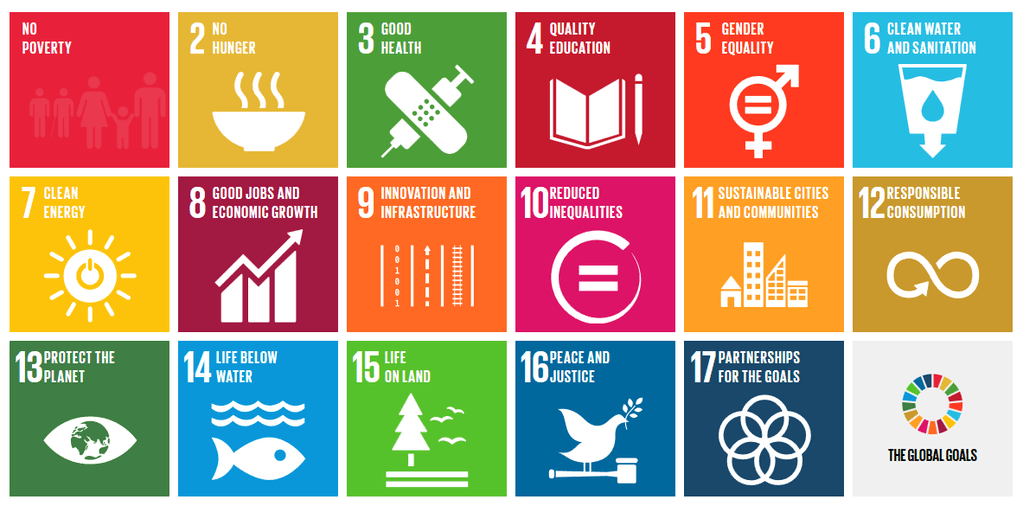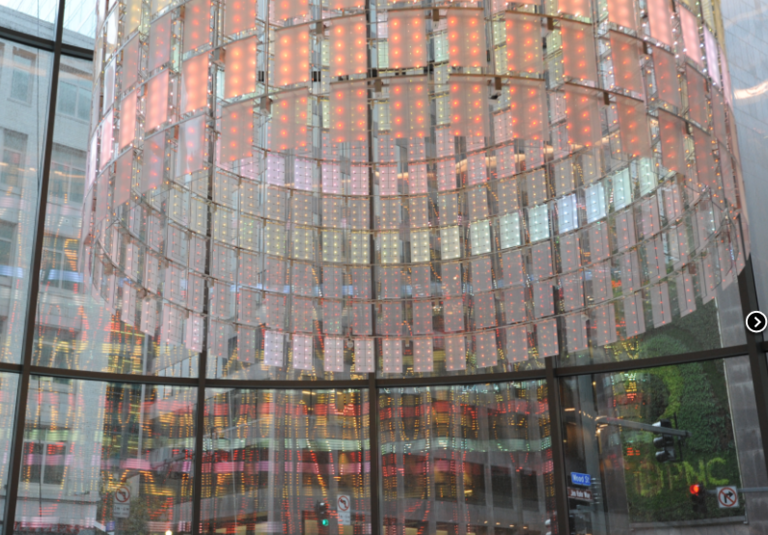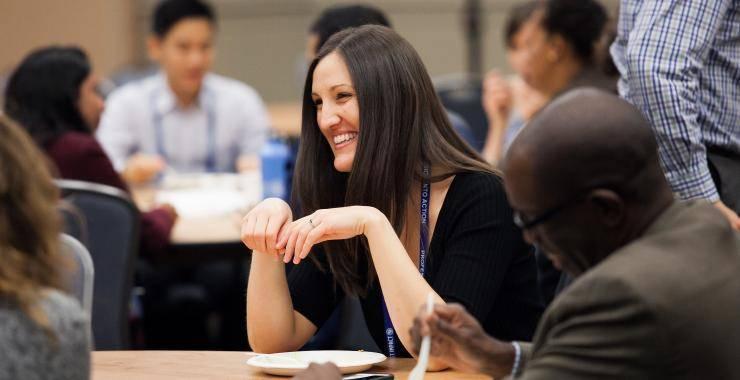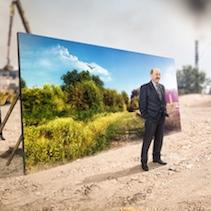How to Align Your Corporate Citizenship Strategy with the UN Sustainable Development Goals


Care about brands taking stands? Join Terracycle CEO Tom Szaky to talk diaper recycling, Leidos CEO Roger Krone on the corporate response to the opioid epidemic, and more at the 2017 Commit!Forum in Washington DC this October.
By Mandy Ryan, Managing Director at Changing Our World
Have you been tasked with addressing how your company supports the United Nations Sustainable Development Goals (SDGs)?
Are you hoping to connect and align your corporate citizenship efforts to a shared global strategy to put your activities in context and amplify your impact?
It’s been about a year and a half since the SDGs – a set of 17 goals such as No Poverty (#1), Quality Education (#4), and Peace, Justice and Strong Institutions (#16) and 169 associated targets – were adopted as a part of the UN’s 2030 Agenda for Sustainable Development. In the time since, leading corporate citizens have begun to tackle the challenge of aligning their citizenship work to the SDGs.
While the 2030 Agenda and the SDGs are intended to provide a shared global framework for addressing society’s greatest challenges, they are in no way a one-size-fits-all roadmap for action. In fact, upon first scanning those 17 goals and 169 targets, which range from reducing premature mortality from non-communicable diseases to significantly increasing the exports of developing countries, figuring out how to align your company’s efforts can feel like an overwhelming task.
Here are some key steps and tips for how to approach this challenge, gleaning learnings from best-in-class examples of corporate alignment to the SDGs, and overlaying these with insights and experience we at Changing Our World have gained working directly with companies on designing and evolving their corporate citizenship strategies.
The roadmap
Know your company
- Understand your objective: There are a number of reasons why companies may wish to align to the SDGs and a range of approaches to take. When beginning this exercise for your company, it’s important to understand where on the spectrum you fall, from mapping your existing efforts to the SDGs for reporting purposes, to leveraging the SDGs to entirely evolve your strategy (or design a new one). Where you fall on this spectrum will dictate the lens you apply to subsequent steps:
- Assess current efforts as they relate to the SDGs: Regardless of your objective, you’ll need to start with an understanding of the SDGs and their targets and a rough idea of where your company may align. Start by reviewing the SDGs; select the goals and targets where you believe your company may have activities and impacts which align. Bucket these activities by business unit and collect information from the relevant “owners” at your company to better understand the programs and results that exist in these areas.
TIP: Don’t neglect to think beyond philanthropic and community involvement programs; certainly, your philanthropic programs (and which SDGs they relate to) should be a starting place, but also consider other business units as well (e.g., Human Resources may have an initiative which supports goal #5, Gender Equality). The following diagram depicts some of the business functions, beyond philanthropy, which companies commonly map to the SDGs.
- Take advantage of the opportunity to extend the reach of your work across the company. As the chart above suggests, the SDGs are broad-reaching and touch upon many areas of business which may not fall within the direct authority or purview of corporate citizenship or your department. Whatever your eventual goal, you will benefit from connecting with leaders and business units across the company, helping them understand your work and how it connects to the core business strategy. Leverage meetings with internal stakeholders to:
- Build buy-in/support: Use this process to demonstrate how peers, competitors and best-in-class companies are focusing on citizenship and aligning to the SDGs.
- Connect across the business: Talk to other departments who previously didn’t understand their contribution to the company’s corporate citizenship strategy; use the relevant SDG targets to demonstrate how they relate and pave the path for future collaboration.
Choose a focus
- Identify and prioritize the SDGs and targets that present the greatest alignment to your business and/or your citizenship goals. While your company’s operations and activities, current and future, may technically allow you to touch on all 17 SDGs, you should select a more focused set of priorities to dedicate the majority of your effort and focus toward. As with many things in life, quality over quantity is a good rule of thumb here. Select the SDGs and targets which best align to your business’ strengths, assets and priorities. You can still report on what you do in other areas, but use the 80:20 rule and focus 80 percent of your time and resources on impact and reporting within the 20 percent of the universe where you can make the greatest impact and tell the strongest story.
- Determine your approach; identify core programs. Whether you’re simply identifying which existing initiatives you will report on relative to the SDGs, establishing new programs targeted at identified SDGs, or something in between, you should develop a high-level framework that articulates which corporate programs and initiatives are aligned to the prioritized SDGs and how the outcomes of these programs help advance the SDGs. If you are taking steps to adjust or evolve your programming, consider joining one of the many pre-existing partnerships/action networks focused on collective action around the various SDGs.
Set goals, track and share progress
- Share your company’s vision and rationale for SDG alignment. Choosing to align to the SDGs at any level is founded, at least to some degree, in a recognition that your company is part of a global community and has a role to play in contributing to that community’s shared agenda for positive social change. Make sure you take the time to articulate why your company is taking action within this shared agenda and targeted goals.
- Set measurable goals within priority areas. Build from your current baselines and establish aspirational goals that have clear and specific metrics and targets that you can use to measure progress. They should be unique to your company and programs; they do not need to be the exact targets within the SDGs, so long as you can show the step-logic for how they ultimately contribute to them.
- Track and communicate progress against goals and within priorities. Develop a system for tracking progress and share your results and learnings with your stakeholders. This is not just to highlight your achievements, though that is certainly important. A shared agenda will not advance if the individual actors are operating in the dark – communicating openly about the work you are doing opens the door for others to learn from your work and build bridges to connect more deeply to your efforts.
Pittsburgh: Leading Green Building Hub?


Once the epicenter of America’s manufacturing prowess, Pittsburgh has undergone decades of transformation as it shifted from its role as the center of the U.S. steel industry to what is now home to one of the leading technology clusters in North America. But in addition to software, biotech and robotics, Pittsburgh has also become one of the leading green building laboratories within the U.S.
Aurora Sharrard, Executive Director of Pittsburgh’s Green Building Alliance and who also manages the media site Pittsburgh Green Story, recently shared her thoughts with TriplePundit on why this city of 304,000 has become a locus of new innovations in sustainable architecture and design.
So how did this Midwestern city known more for its sports teams and steel than innovative and energy efficient buildings become an area that shines as a playbook for green building standards such as LEED and BREEAM?
Opportunity, philanthropy and an attention to detail are a few ways in which Sharrard sums up Pittsburgh’s commitment to making current and future buildings healthier places in which to live, work and play. The region’s leading companies and universities were certainly helpful on this front as well, as they were crucial in the development of partnerships that transformed much of Pittsburgh’s commercial space. Much of this work is occurring within the Pittsburgh 2030 District, collections of high-performance buildings throughout downtown Pittsburgh, as well as the Oakland area, home to the city’s leading academic and healthcare institutions.
When it comes to fostering green building opportunities, Pittsburgh’s layout certainly helps. The city is only 58 square miles - contrast that size cities of similar populations, as in Tulsa, OK (more than three times the size of Pittsburgh) or Lexington, KY (almost five times its land area).
The city’s location allows for these next-gen buildings to be complemented by convenient transportation and mobility options. Sharrard explained that in Pittsburgh alone, transportation represents only 18 percent of all greenhouse gas emissions, compared to the overall U.S. average of 27 percent. Sharrard also referenced a study the Alliance completed in 2015 that analyzed over 20,000 surveys of local commuters. The group found that 34 percent of these commuters reported that they used more than one mode of transportation each week; fewer than half of them drove to work alone; approximately 25 percent took public transportation, and nearly 10 percent biked, walked, or telecommuted. The city’s compactness is one reason why it has attracted the likes of Uber (though that relationship can be described as tense at best) and artificial intelligence companies that together harness “Steel City” as a test bed for autonomous vehicle technology.
Once they arrive at work, these same commuters are most likely walking into one of the country’s most sustainable workspaces. Sharrard claimed that Pittsburgh’s 2030 District is the largest of 17 similar districts across North America, with 493 buildings totaling 78.7 million square feet, which in turn will push Pittsburgh closer to meeting its goals of 50 percent reductions in energy consumption, water usage, and transportation emissions by 2030. “Whether you’re using certifications, measured performance, or other innovative approaches,” said Sharrard, “there is no question that Pittsburghers remain committed to ensuring that their buildings are sustainable by any measure.”
Pittsburgh’s legacy of corporate philanthropy was also a factor in the city’s green building boom. One example is seed funding from The Heinz Endowments, which in part allowed the Alliance to become one of the first nonprofits in the United States to focus on retrofitting a region’s commercial building sector so that more of its space could become more sustainable. The support from Heinz sparked many public, private, and nonprofit partnerships that positioned Pittsburgh as a leader of this movement. In 2000, three of the first 13 LEED certified buildings were in Pittsburgh; by 2005, Pittsburgh had more certified green buildings by number and square footage than any other city in America. Support from organizations such as the Richard King Mellon Foundation and The Pittsburgh Foundation have also worked with the city’s neighborhoods and buildings to become more sustainable in recent years.
The numbers are difficult to argue with: Sharrard says that these collective efforts help the city conserve over 760 million kilowatt hours (kWh) of energy, equal to the annual energy use of over 32,000 homes or 4.5 billion miles driven by car – in the meantime preventing over 305,610 tons of carbon that otherwise would have been emitted into the atmosphere. Water savings have added up, too, with 74.5 million gallons avoided in 2016, and a total of 222.8 million gallons avoided since 2014, which in turn saved these buildings’ owners or renters $4.6 million.
The attention to detail on each individual project accumulated to those aforementioned savings. One example is Tower at PNC Plaza. When PNC and Gensler launched the project several years ago, the overarching goal was to design and build the greenest high-rise on earth. The 544-foot tall building, which opened in 2015, includes features such as a double-skinned façade, a solar chimney permitting natural ventilation and grey water systems. But the tower not only allows its largest tenant, PNC Financial Services, to save on operating costs; it also enhances employees’ health, productivity and overall experience. Natural light flows into the building, and on the 28th floor, an indoor park with five stories of glass allow occupants and visitors to look out onto adjacent Market Square. Anyone in the building can take his or her laptop up there to do work or meet a colleague for lunch. In the end, Sharrard said the building’s design was instrumental in boosting engagement and morale at PNC while allowing for more collaboration within the company.
The efforts of organizations including the Alliance and its partners are achieving more than contributing to its overall goals of making the city far more energy- and water-efficient. They are also striving to improve employees’ indoor air quality, allow companies to seek increased returns on their investments, and contribute to the region’s overall growth and success. “Once known as the smoky city, Pittsburgh’s environmental renaissance has been dramatic enough to make other metropolitan areas green with envy,” wrote Eric Heyl on Patch.com earlier this year.
Half Of UK workers say 'no need' to sacrifice profits for higher ESG


By Roger Aitken — Around half (47%) of UK workers believe that companies can achieve higher environmental, social and governance (ESG) standards “without sacrificing profitability”, according to new research that canvassed a panel of respondents spanning chief executives, directors, company owners as well as other staff.
The research, which was conducted by strategic insight agency Opinium and based on online interviews with 500 UK adults between 12 January to 27 April 2017, revealed that just over half (52%) of workers believe companies should consider ESG issues because it is “morally the correct thing to do.”
In terms of Opinium’s sample, 57% of respondents were in senior managerial positions or above.
James Endersby, Managing Director from Opinium Research, remarking in the wake of the survey results: “It’s fantastic to see ESG issues becoming more of a consideration for businesses over the last five years and encouraging that many feel they can incorporate this consideration into their business strategy without sacrificing profits.”
According to Mark Evans, Director of the Better Society Network, which conducts research into responsible business and the corporate and financial engagement with social and environmental issues, commenting said: “Many companies now can see that their organisation’s ESG position is driving higher long-term profitability.”
He added: “This represents a sea change in perception; ESG was only notionally considered in the previous decades, but now is not only fully accepted, but seen as no impediment to profit.”
Among other key findings in the survey, one in eight (12%) say profits should be impacted if necessary to raise such standards, but a quarter (24%) say they would be unwilling to accept sacrificing profitability for the sake of ESG.
And, almost two-fifths (38%) of UK workers believe their company’s consideration of ESG issues has risen over the last five years, it was found. Only 2% believe these concerns have reduced.
The research also reveals a degree of pragmatism, with 28% expressing the view that ESG issues need to be considered to legally protect their company, while over a tad over a quarter (26%) say that ESG considerations are “ultimately necessary” to be more successful.
This latter belief is not skewed in any particular generation - while 25% of Millennials (18-34 year olds) believe this, 26% of 35 to 55-plus believe this, too.
Despite the growing concerns, UK companies are remarkably reticent when it comes to highlighting their efforts with regards to ESG. The majority of workers (53%) say their companies do not publicise their ESG activities at all. The most popular platform for doing so is internal communications, yet only one in five (21%) uses this.
Other methods include the annual company report (17%); press releases (11%); sponsorship (10%); and advertising (9%).
Perhaps interestingly, 27% of respondents say they have no idea whether their company is planning to improve its approach to ESG issues. Although entering awards can be used to highlight ESG activities, only 10% of companies do this, while 9% collaborate with an external partner such as a charity or community group and 9% hold consultations or events.
Jonathan Flint, Managing Director of international PR firm Citigate Dewe Rogerson that has served over 500 clients from start-ups to some of the world’s largest listed companies, said: “Public consciousness of ESG issues continues to rise, putting ever more pressure on companies to demonstrate good behaviour.”
But despite this, he added: “It is surprising that our research shows how little companies are doing to highlight their ESG activities. The potential to enhance their reputations further with comprehensive communications is substantial.”
Reputation among clients and potential clients is seen as important to their organisation by four in five (81%), while 75% believe that their company cares how the public perceives them and two thirds (67%) think that the reputation of their organisation to employees and potential employees is significant.
We are Designing our NI17 Program for You!


Whether you are passionate about protecting the environment, reversing climate change, reimaging food systems, investing for impact, fighting for equity and social justice - or anything in between - the 2017 Net Impact Conference is for you!
Our specially crafted program is designed to take your passions and turn them into a tangible career. You can discover jobs in corporate responsibility, explore the details of nonprofit work, or gain new insights into starting your own social enterprise. Through panels, workshops, and networking opportunities you will also build connections with impact leaders who can offer support and guidance as you continue on your career path.
Some of these impact leaders include Abe Taleb, CEO of ReWork, Rohit Malhotra, Founder and Executive Director for the Center for Civic Innovation, and Jessica Fleuti, Curator, Skoll Convenings for the Skoll Foundation. For those interested in food systems, hear from Dave Stangis, the Vice President for Public Affairs and Corporate Responsibility at Campbell Soup Company. Are you looking for a career in impact investing? Then connect with NI17 speaker Rehana Nathoo, the Vice President of Social Innovation and Impact Investing for the Case Foundation. Perhaps you are passionate about fighting for equity and social justice? A workshop with Racy Conversations founder Karen Fleshman could be the event for you.
Each day of our event will equip you with the tangible skills to land your dream job with purpose. We will have recruiters on site or you can take your portfolio of new experiences and connections with you as you pursue future career opportunities.
Register for the 2017 Net Impact Conference to accelerate your impact career while staying on top of the latest trends in social and environmental change and having fun with your passionate and engaged peers in vibrant Atlanta. While we continue to work hard to refine the details, we hope you enjoyed this snapshot of what you can expect from our incredible conference program this year.
3p Weekend Round-Up: Latest Count on Companies Standing Against Racism


With a busy week behind you and the weekend within reach, there’s no shame in taking things a bit easy on Friday afternoon. With this in mind, every Friday TriplePundit will give you a fun, easy read on a topic you care about. So, take a break from those endless email threads, and spend five minutes catching up on the latest trends in sustainability and business.
It has been a dramatic week, to say the least, as the nation recovers from the biggest white supremacist rally in decades. Instead of calming the nation, President Trump pandered to white nationalists, fueling the flames.
Finally, FINALLY the tide is turning and corporations are shifting from keeping mum to taking a stand, of one kind or another, against racism and hateful rhetoric.
Before we get into our round-up, we'd be remiss if we didn't mention those early bold actors who were not afraid to speak out before it was the popular thing to do. For example, venture capitalist Ellen K. Pao, a partner in San Francisco based Kapour Capital, did not wait for Trump's "alt-right" base to cross the bridge from online rhetoric to outright murder.
In the run-up to Election Day last fall, Pao publicly severed relations with the high-powered startup incubator YCombinator, citing its ties to the Trump campaign's advocacy of "hatred and violence."
On the other hand, better late than never. With that in mind, here's the first in what will probably be a running TriplePundit homage to business leaders who have staked out a corporate social responsibility position in support of traditional American values, namely, the equal and inalienable right to life, liberty and the pursuit of happiness.
The Trump CEO boycott, Wave 1: The Muslim Ban and the Paris Agreement on Climate Change
In hindsight, the notorious Muslim ban in the very first days of the Trump Administration should have sent corporate America running for the exits. Hundreds of top business leaders did sign letters and statements opposing the ban, but the members of Trump's newly established advisory groups -- the American Manufacturing Council and the tech-centric Strategic and Policy Forum -- stood fast.
Former Uber CEO Travis Kalanick was the only executive to walk the walk. In February, he resigned from the Manufacturing Council ahead of a threatened consumer boycott, explaining that joining the group "was not meant to be an endorsement of the president or his agenda but unfortunately it has been misinterpreted to be exactly that.”
It wasn't until several months later, on June 1, that Kalanick got company. June 1 was the day Trump announced that the U.S. would pull out of the global Paris Agreement on Climate Change.
Telsa's Elon Musk decided that was the last straw. He promptly tweeted to his 11.5 million followers:
Am departing presidential councils. Climate change is real. Leaving Paris is not good for America or the world.Disney CEO Bob Iger also had enough:
As a matter of principle, I've resigned from the President's Council over the#ParisAgreement withdrawal.
Disney followed up by posting a longer version of Iger's tweet:
"Protecting our planet and driving economic growth are critical to our future, and they aren't mutually exclusive. I deeply disagree with the decision to withdraw from the Paris Agreement and, as a matter of principle, I've resigned from the president's advisory council."
Wave 2: the Charlottesville exodus begins
Last weekend's violence in Charlottesville Va. was documented in chilling detail by Vice News in a documentary that aired on Monday, August 14.
The President's tepid response last Saturday struck a negative chord, and he came out with an alternative response on Monday that was better received.
However, by then the damage was done.
Merck CEO Kenneth Frazier lead the charge on Monday morning. He withdrew from the Manufacturing Council stating that, "as a matter of personal conscience, I feel a responsibility to take a stand against intolerance and extremism.”
Intel CEO Brian Krzanich wrote in a blog post Monday night announcing his decision to quit the advisory council:
I resigned because I want to make progress, while many in Washington seem more concerned with attacking anyone who disagrees with them. We should honor – not attack – those who have stood up for equality and other cherished American values.Under Armour CEO Kevin Plank, who was burned earlier this year by the company's own celebrity endorser, and many others, for a mild compliment he paid to Trump, quit with this blistering observation:
AFL-CIO President Richard Trumka announced his withdrawal on Tuesday. He made up for the 24-hour time lag with a forceful statement personally calling out Trump. On Tuesday evening he tweeted:...I love our country and our company and will continue to focus my efforts on inspiring every person that they can do anything through the power of sport which promotes unity, diversity and inclusion.
I cannot sit on a council for a President that tolerates bigotry and domestic terrorism; I resign, effective immediately.
Strongly-worded internal memos also later surfaced from Microsoft's Satya Nadella and Walmart's Doug McMillon to their employees on Monday in reaction to the events in Charlottesville, but as of Tuesday only a handful of CEOs had actually quit either of Trump's councils.
Wave 3: the pot boils over
Trumka's response was a harbinger of things to come. On Wednesday, Trump followed up a press conference on infrastructure with a series of incendiary off-the-cuff remarks in which he walked back his Monday remarks and defended the white nationalist marchers in Charlottesville.
By the end of the day the entire body of both councils quit, effectively making the boycott a 100 percent action. Trump had earlier claimed that he could replace the missing members, but the overwhelming response could not be ignored. Before the councils had a chance to make a formal announcement, Trump announced that he was disbanding them.
That afternoon, BuzzfeedNews assembled statements from some of the boycotters. Following are snippets -- do read the article for full statements.
GE Chairman Jeff Immelt:
"The President’s statements yesterday were deeply troubling. There would be no GE without people of all races, religions, genders, and sexual orientations. GE has no tolerance for hate, bigotry, racism, and the white supremacist extremism that the country witnessed in Charlottesville last weekend."United Technologies CEO Greg Hayes:
...as the events of the last week have unfolded here in the U.S., it is clear that we need to collectively stand together and denounce the politics of hate, intolerance and racism. The values that are the cornerstone of our culture: tolerance, diversity, empathy and trust, must be affirmed by our actions every day.3M CEO Inge Thulin:
"Sustainability, diversity and inclusion are my personal values and also fundamental to the 3M Vision. The past few months have provided me with an opportunity to reflect upon my commitment to these values.
Johnson & Johnson CEO Alex Gorsky:
The President's most recent statements equating those who are motivated by race-based hate with those who stand up against hatred is unacceptable...Campbell Soup Company CEO Denise Morrison:
Racism and murder are unequivocably reprehensible and are not morally equivalent to anything else that happened in Charlottesville...Alliance for American Manufacturing President Scott Paul:
We must always take sides. Neutrality helps the oppressor, never the victim.
By Thursday, Fortune Magazine added more names to the rapidly growing list (again, read the article for more detail):
Heartbroken by the violence in
#Charlottesville. Hate and intolerance are a betrayal of what we stand for as Americans.
"...There is no room for equivocation here: the evil on display by these perpetrators of hate should be condemned and has no place in a country that draws strength from our diversity and humanity."
The despicable conduct of hate groups in Charlottesville last weekend, and the violence and death that resulted from it, shows yet again that our nation needs to focus on unity, inclusion, and tolerance.
GM CEO Mary Barra:
Recent events, particularly those in Charlottesville, Virginia, and its aftermath, require that we come together as a country and reinforce values and ideals that unite us - tolerance, inclusion and diversity – and speak against those which divide us – racism, bigotry and any politics based on ethnicity.
Johnson & Johnson CEO Alex Gorsky:
...I believe, very strongly, that hatred and bigotry of any kind have no place in our society.
Peebles Corporation's Don Peebles:
When it comes to racism and anti-Semitism and fairness, you can't walk a gray line.
Dow CEO Andrew Liveris summed it all up:
Every member of the Manufacturing Jobs Initiative condemns racism and bigotry, and there cannot be moral ambiguity around the driving forces of the events in Charlottesville.
Annie's Homegrown (Owned by General Mills) CEO John Foraker was done with the typical CEO speak that requires beating around the bush:
How bout a gofundme & take all the confederate statues being removed & ship them to Mar A Lago to be with fellow #assholes
— John Foraker (@jforakerceo) August 17, 2017
Silicon Valley steps up -- to shut down hate rhetoric
Regardless of whether or not they were Trump advisors, top dot-com execs have emerged among the president's strongest critics, and they are in a position to fill the leadership gap left by Trump -- with action, not just words.
Apple CEO Tim Cook was among them, as reported by BuzzFeed:
I disagree with the president and others who believe that there is a moral equivalence between white supremacists and Nazis, and those who oppose them by standing up for human rights. Equating the two runs counter to our ideals as Americans.
In a lengthy memo, Cook pledged contributions of $1 million each to the Southern Poverty Law Center and the Anti-Defamation League. Apple is also matching employee donations, and it is setting up an iTunes channel for the public to join in contributing.
Facebook's Mark Zuckerberg had this to say (in a Facebook post, of course):
It's a disgrace that we still need to say that neo-Nazis and white supremacists are wrong -- as if this is somehow not obvious.
He also pledged to double down on efforts to keep hate groups out of the site:
...With the potential for more rallies, we're watching the situation closely and will take down threats of physical harm. We won't always be perfect, but you have my commitment that we'll keep working to make Facebook a place where everyone can feel safe.
Other dot-coms have also taken action. CNBC provides this rundown:
Ahead of the rally, Airbnb barred housing rentals to people it believed were traveling to participate. Before and after Charlottesville, PayPal cut off payments to groups that promote hate and violence. GoDaddy and Google yanked the domain name for Daily Stormer following the rally. Facebook, Twitter and Instagram are removing known hate groups from their services, and the music streaming service Spotify dropped what it considers hate bands.
The web services provider CloudFlare has been slow to react, but apparently it is also gearing up:
“Cloudflare is aware of the concerns that have been raised over some sites that have used our network. We find the content on some of these sites repugnant. While our policy is to not comment on any user specifically, we are cooperating with law enforcement in any investigation.”
Tech Crunch also reports that Sendgrid and Zoho are among the other service providers clamping down on access by Daily Stormer and other hate groups.
Trump losing friends, fast
Nonprofits are also beginning to bail on Trump, and his Mar-a-Lago venue is taking the heat. The American Cancer Society, the Cleveland Clinic and the Israeli Red Cross (AFDMA) are reportedly pulling out of events scheduled for next year, and there are probably more on the way.
Even Trump's friends over at Fox News have been wavering. New York Times reporter Maggie Haberman tweeted the contents of a personal email from James Murdoch, chairman of Fox News parent company 21st Century Fox, which collectively conveyed this message:
What we watched this last week in Charlottesville and the reaction to it by the President of the United States concern all of us as Americans and free people. These events remind us all why vigilance against hate and bigotry is an eternal obligation - a necessary discipline for the preservation of our way of life and our ideals. I can’t even believe I have to write this: standing up to Nazis is essential; there are no good Nazis. Or Klansmen, or terrorists.
Now that it has become clear that hate does not boost the bottom line, we expect more companies will be making the decision to publicly distance themselves from the Trump administration. It's about time!
Photo: by Gage Skidmore/flickr, creative commons license.
The Industrious Bee: Replacing Plastic Products with Beeswax


The greatest challenge to “going green” these days is finding suitable replacements for our carbon-based conveniences. Things like plastic wrap and zip-lock bags have become household mainstays. Plastic packaging can extend the life of fresh food like meat as much as 4-5 days on the shelf.
The environmental cost of materials that by and large aren't being recycled, however, is significant. According to a study by the Ellen McArthur Foundation, of the 78 million tons of plastic packaging that was produced in 2013, 40 percent of it ended up in the landfill. That includes plastic wrap and baggies that often don't make it into a recycle stream.
But apiarists may have found an answer. And they have early pioneers -- and bees -- to thank for the solution.
Long before plastic wrap was on the market, there was beeswax. Ancient Egyptians used it as a preservative in many functions, including writing. Artists have used it to strengthen clay in sculptures and model-making. Of late, it's become the magic ingredient for everything from candies to candles.
Several new start-up companies have figured out a way to use those same adaptable characteristics to benefit food preservation. etee, based in Toronto, Ontario Canada, spent about a year researching the properties of beeswax in an effort to create a pliable food wrap that didn't have to be chucked into the garbage after one use.
What the company discovered was that by adding essential oils and soy or resin to the beeswax, and then infusing organic cotton with the mixture, they were able to create a flexible "sticky" wrap that was not only reusable but had antimicrobial properties to help guard against food spoilage.
According to etee, beeswax wraps work best for preserving cold foods like leftovers, fruits and vegetables and for providing pliable covers for bowls and other utensils. etee doesn't advise using the product for wrapping raw meats. But it does point out that the wraps can be easily washed in light, soapy cold water and reused as many as 150 times.
Other companies like Bee's Wrap offer their own colorful versions of this technique, each with a compendium of secret ingredients to ensure the beeswax stays flexible.
As I read through this growing list of beeswax household products, I worried about the bees. Would expanding an industry that relies on their by-product be harmful?
To get that answer, I reached out to two apiarists from British Columbia's honey-producing region: my brother, Jeff Lee and his wife, Amanda Goodman Lee. Jeff and Amanda are the owners and founders of Honey Bee Zen Apiaries Ltd., which produces the Swan Valley Honey brand in Kootenays and niche varietal honeys from the Vancouver Metropolitan market. Jeff also serves as the First Vice President of the BC Honey Producers' Association, which represents one of the largest sectors of the Canadian honey market.
According to Jeff, beeswax wrap isn't really new. It's a modern take-off on an old and trustworthy method of food preservation.
"Think of 'wax paper' as sandwich wrap," he said. "The precursor was waxed cloth," back before it became cheaper to use a byproduct from carbon-based extractives. The budding food wrap industries of the mid-20th century figured out that there was sense in the way that early homemakers preserved their foods, that could then be capitalized on with the advent of wax paper. That is, until more durable plastic versions of wrap came along.
Still, Jeff said, "there's been a real uptick in this kind of product being produced," with companies like etee and Bee's Wax discovering the secret to larger mass-production.
The wraps are simply a natural way to reuse what is left behind from the bee's busy production cycle. "It's a good use of wax, a byproduct we produce from extracting honey," said Jeff.
It's hard to imagine busy cooks opting for washable, reusable food preservation methods in the place of pre-made plastic bags and and wrap. The same of course, was probably said at the advent of the plastics industry. Today, almost a century after that transition, we seem to be at a new starting point, this time with a growing number of consumers that are willing to take on a bit more kitchen work if it means decreasing the global demand for plastic products.
Flickr/Jenia M
Why "Workers’ Comp" Are Not Dirty Words: CSR and Workplace Injuries


By Hattie E. James
In the business world, few phrases carry as much emotional baggage as “workers’ compensation.” Those who receive it, like most people who file personal injury claims, are often stereotyped as “lazy” or “greedy.” In an ongoing effort to detect fraud, many companies go to extensive lengths to scrutinize such claims. It’s enough to make an employee feel guilty for getting injured on the job.
With the stress of liability weighing on their shoulders, employers can get into the habit of thinking of workers’ compensation as “dirty words.” Worse, entrepreneurs may get into the mindset that injured employees are out to scam them, as though a rising epidemic of dishonesty will threaten to drill an endless pit in their bottom line.
However, as noted by the Bureau of Labor Statistics, the number of nonfatal workplace injuries has been on a steady decline over the last decade. The number of cases of employee fraud have actually gone down over the years. For the most part, workers’ compensation is working as it was intended: as a protection for employees.
One statistic that has increased, however, is the number of lawsuits concerning retaliatory actions made by employers against employees who filed workers’ comp claims. Workers’ compensation isn’t a threat to businesses; in fact, it protects them. In the past, employees had to sue employers to receive compensation for injuries. Workers’ compensation laws replace legal liability with no-fault insurance. Taking a hostile approach to these claims is a fruitless endeavor. Overly reactionary, aggressive workplaces can cost businesses millions of dollars by illegally retaliating against those who file claims.
Say “no” to retaliation
Filing for workers’ compensation can be a daunting proposition. The fear of retaliation — of being incessantly scrutinized, bullied, and even ostracized — can make employees reticent to even file a claim in the first place.
This fear is a product of the work of (perhaps unreasonably) enthusiastic insurers and risk management professionals who often order employees to inform a supervisor when they see signs of workers’ compensation fraud. The natural assumption is, of course, that employers are extremely suspicious of all workers’ compensation cases.
Worse, there are countless stories of business who really did retaliate against employees for filing such claims. Employees who have done so in the past have been excluded from meetings, reassigned to less favorable positions, given suspiciously low performance reviews, and generally pressured to drop a claim. Anecdotes in this vein feed into the idea that filing a claim after being injured on the job is a mistake.
Workers' compensation is a necessary protection
On the contrary, filing for workers’ compensation is nothing to be ashamed of, nor is doing so an engraved indictment of a business for insufficient safety measures. Employees and employers in the U.S. need to dispel the myths surrounding it. Most employees who file for compensation are not “faking it,” and even the most prepared business owner can’t safeguard their employees against every possible injury. Workers’ comp is merely a protection; it ensures that an employee’s livelihood cannot be endangered while on the job.
And, fortunately for employees in the States, this protection carries on for as long as their medical concerns do. For certain injuries or complications, they can continue to collect workers’ compensation. For example, look at the case of a nurse in Pennsylvania who was exposed to the herpes simplex virus while at work. In 2007, complications from the virus led to blindness in her left eye. Although she left employment with the hospital in 1985, she continues to receive workers’ compensation. While a complex legal battle ensued over her right to receive this compensation, the Workers’ Compensation Act helped protect her as intended.
Workers' comp and corporate social responsibilityIf a workplace creates an atmosphere of fear surrounding workers’ compensation, they dissuade employees from filing such claims. And, of course, if an employee fails to seek medical attention, they may exacerbate their injury or condition. A business cannot accurately claim to care about its employees if it promotes such behavior — intentionally or otherwise.
This means that businesses should adopt a positive mindset in regards to workplace safety. Instead of calling for employees to report on possible workers’ comp fraud, they should have employees practice this level of vigilance when it comes to reporting potential workplace safety hazards. Simply put, better work environments mean better productivity. Rather than creating a toxic work environment by ostracizing employees who dare to file a claim, they should show compassion by addressing safety issues and encouraging employees to be open about their experiences while on the job.
Corporate social responsibility also entails educating employees about risks in the workplace and enforcing safety protocols. For example, in the case detailed above, a well-informed risk management professional might advise the employer to strengthen their focus on educating nurses about the occupational hazards of working around illnesses.
Furthermore, the hospital could adopt programs to reduce stress, thereby reducing the number of workplace injuries to begin with. Some hospital administrations have found creative ways to combat stress. For instance, Rush University Medical center offers a program called “Pet Pause,” which consists of free animal therapy sessions with specially trained dogs. It has had a measurable effect on reducing stress, including decreased blood pressure and lower triglyceride and cholesterol levels. Measures like this not only demonstrate to employees that management legitimately cares about them, but it can also reduce claims. Alleviating stress reduces mental and emotional injuries, which could otherwise lead to claims in regards to sleep disorders, panic attacks and depression.
For the benefit of everyone in the workplace, misinformation about workers’ compensation needs to end. Instead of creating fear about filing claims, businesses should demonstrate care and understanding. Filing a claim after an injury is not a hostile act on the part of the employee, and it is rarely done fraudulently. To foster a more positive relationship between employers and employees going forward, we need to drop the emotional weight connected to the phrase “workers’ compensation.”
Hattie E. James, MBA, is a writer and researcher.
The Apparel Industry’s Environmental Impact in Six Graphics


By Deborah Drew and Genevieve Yehounme
A version of this article was originally published by World Resources Institute
Roughly 20 pieces of clothing per person are manufactured each year. Growth of the multi-trillion-dollar apparel industry has been fed by “fast fashion,” which makes clothing cheaply and quickly with a low price-tag. These visuals illustrate why the apparel industry must embrace a new approach to sustainably meet demand in tomorrow’s markets.
Increased Production and Consumption
Fast fashion uses innovative production and distribution models to dramatically shorten fashion cycles, sometimes getting a garment from the designer to the customer in a matter of a weeks instead of months. The number of fashion seasons has increased from two a year – spring/summer and fall/winter – to as many as 50-100 microseasons.
Fast-changing trends and low prices have allowed people to consume more. The average consumer is now purchasing 60 percent more items of clothing compared to 2000, but each garment is kept half as long.
Water Stress and Pollution Cotton is the most common natural fiber used to make clothing, accounting for about 33 percent of all fibers found in textiles. Cotton is also a very thirsty crop, requiring 2,700 liters of water—what one person drinks in two-and-a-half years—to make one cotton shirt. In areas already facing water stress, cotton production can be particularly damaging. In Central Asia, for instance, the Aral Sea has nearly disappeared because cotton farmers draw excessively from the Amu Darya and Syr Darya rivers. (Check out WRI’s Aqueduct tool to see where cotton production and water risks intersect.) Cotton farming is also responsible for 24 percent of insecticides and 11 percent of pesticides despite using about 3 percent of the world’s arable land.
Water use and pollution also take place during clothing production. About 20 percent of industrial water pollution is due to garment manufacturing, while the world uses 5 trillion liters (1.3 trillion gallons) of water each year for fabric dyeing alone, enough to fill 2 million Olympic-sized swimming pools.
Climate Change The carbon footprint of a garment largely depends on the material. While synthetic fibers like polyester have less impact on water and land than grown materials like cotton, they emit more greenhouse gasses per kilogram. A polyester shirt has more than double the carbon footprint of a cotton shirt (5.5 kg vs. 2.1 kg, or 12.1 pounds vs 4.6 pounds). Polyester production for textiles released about 706 billion kg (1.5 trillion pounds) of greenhouse gases in 2015, the equivalent of 185 coal-fired power plants' annual emissions.
What’s apparel’s future? Apparel spending is projected to grow tremendously. This is particularly true in Asia, as hundreds of millions of people in China and India enter the global middle class.
By 2030, there will be 5.4 billion people in the global middle class, up from 3 billion in 2015. We can expect increased demand for clothes and other goods that define middle-income lifestyles. If consumption continues at its current rate, we’ll need three times as many natural resources by 2050 compared to what we used in 2000.
Assuming infinite resources in a finite world is not a sustainable business model. Beyond environmental concerns, unchecked consumption will undermine the world’s economic and social goals. Some apparel companies will ignore those signals and continue with traditional take-make-waste business models. Others will embrace innovative new models that work within planetary boundaries and are a better fit for tomorrow’s markets.
What to do? Apparel is just one sector competing for natural resources, but it’s important that clothing makers start transforming their business models now given the industry’s strong growth trajectory. Many companies are aware of the environmental risks and are ready to act.
The first step is for companies to measure their environmental impacts and understand areas where they can improve. The Sustainable Apparel Coalition’s Higg Index lets companies measure the environmental, social and labor impacts of their products and services, and work is being done on Science Based Targets guidance for the apparel industry.
Some companies are working to improve their resource efficiency. H&M and Zara, both purveyors of fast fashion, joined 33 other fashion companies in a pledge to increase their clothing recycling by 2020 and are collecting and recycling used clothing at many of their stores. Reformation, a smaller Los Angeles-based clothing brand that is gaining popularity, claims that it produces its clothing with far less water and emissions than typical clothing companies, and even publishes the spared water and emissions quantities on each product webpage.
The next step is to recognize that companies must do more than improve efficiency to sustainably meet demand in the years ahead. They must produce less stuff. Some companies have already acknowledged this and are testing new models, though these examples are still the exception rather than the rule. Patagonia’s Worn Wear program offers a service to fix old clothes rather than only sell new ones. Companies like Mud Jeans, Rent the Runway and Gwynnie Bee are experimenting with rental models. Some companies, such as Zady’s, are calling for a return to “slow fashion,” promoting it as a key component to their business model.
To keep the apparel industry viable in tomorrow’s markets, the issue of consumption must be brought to the forefront—and it must begin now.
Photo credit: Flickr / Jennie-O
Graphics: WRI
Big Oil urged to report financials in view of climate-related risk


White Nationalist Site Daily Stormer Goes Dark Thanks to Activist Web Services Co.


As debates over free speech, hate speech and the First Amendment ratchet up in the wake of last weekend’s violence in Charlottesville, tech companies have found that they are compelled to take action. And they have concluded that they can simply take on hate speech, white supremacists and neo-Nazis by doing a simple thing: deny them a platform, or refuse to provide services to such organizations.
The latest example is the web services company Cloudfare. In a blog post yesterday, the company’s CEO, Matthew Prince, announced it had terminated all services provided to the Daily Stormer. The company says it no longer funnels any of the web site’s traffic through its proxy servers, nor will it answer any of the site’s DNS requests (which matches domain names to numeric IP addresses). “The tipping point for us making this decision was that the team behind Daily Stormer made the claim that we were secretly supporters of their ideology,” said Prince.
Cloudfare’s announcement comes merely days after GoDaddy booted the Daily Stormer after an outcry against that business relationship swelled on Twitter. The site resurfaced on a Google platform, but the company was quick to shut it down. Yesterday, the site resurfaced using a Russian domain name, but as news outlets such as The Verge reported, it once again quickly disappeared, too.
According to Avi Selk of the Washington Post, other technology companies, ranging from Uber to PayPal, also have taken action by kicking off anyone linked to the Daily Stormer. And other companies that provided web-related, chatting or email newsletter services, such as Zoho, Discord and SendGrid, nixed any ties to the web site, citing violations of their terms of services.
Those companies have followed the lead of Airbnb, which was more proactive than reactive as late last week, the company cancelled accounts of users tied to the “Unite the Right” march access to its online accommodation and room-sharing service.
According to an email (published verbatim by Gizmodo) Prince had sent to Cloudfare’s employees, the company had no choice but to follow suit. Prince and Cloudfare had been stubborn about remaining content-neutral – long an ideal of the libertarian Silicon Valley crowd, but a policy that opened them up to criticism that they were enabling hate speech and harassment. While noting that CloudFare had the right to terminate services at its sole discretion, Prince made it clear that this was a one-time arbitrary decision. Yet unlike his blog post, Prince refused to mince words in addressing Cloudfare’s staff. “The people behind the Daily Stormer are a--holes and I’d had enough,” he wrote.
Many readers were furious at Prince’s decision. “Cloudflare cries out in pain as it censors you,” wrote one commenter. “You folded to political pressure,” chimed in another.
Cloudfare, however, found that any concerns over stirring the pot over whether the internet is truly “free,” while at the same time offending some internet users, was outweighed by the risk that enabling hate speech could harm its business in the long run. Other technology companies, such as Twitter, have witnessed their reputations suffer as they took far too long to cut off people who had sparked harassment against other Twitter users. And considering the violence that engulfed Charlottesville last Saturday, Cloudfare realized having any links to the white supremacist movement was a risk no longer worth bearing.
Image credit: Evan Nesterak/Flickr